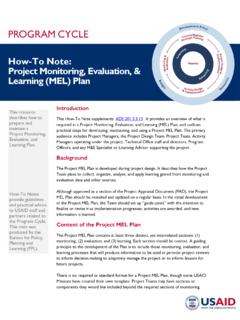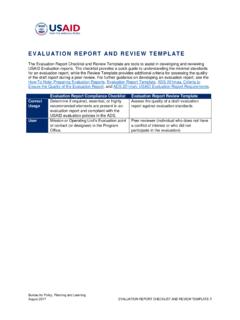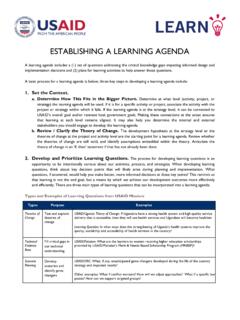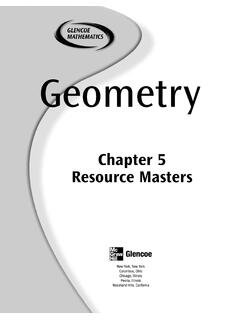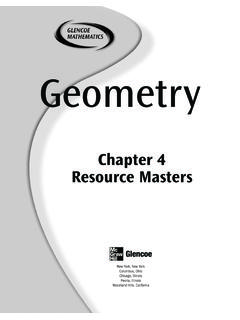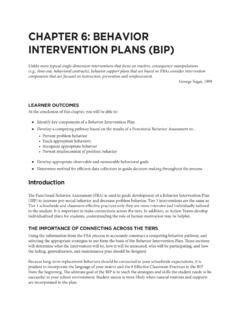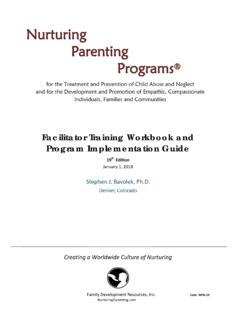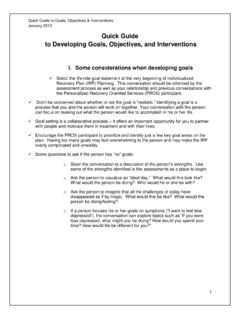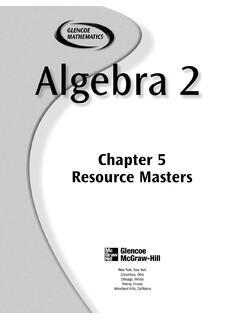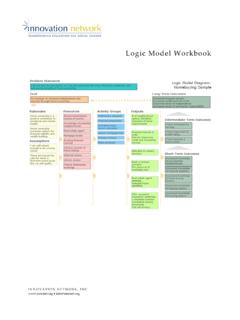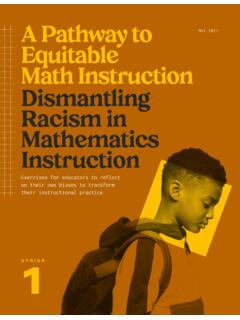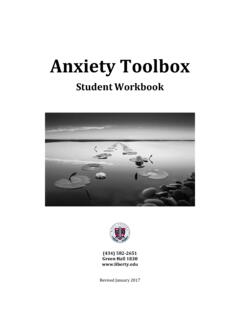Transcription of Model Measurement Workbook
1 MENA OfficeOutcome Harvesting May 2012 Ricardo Wilson-GrauHeather BrittOutcome Harvesting i This publication was supported through a Foundation Administered Project (FAP) funded and managed by the Ford Foundation s Middle East and North Africa Office Box 2344 1 Osiris Street, 7th Floor Garden City, 11511 Cairo, Egypt T (+202) 2795-2121 F (+202) 2795-4018 2012 Ricardo Wilson-Grau and Heather Britt 2012 Ford Foundation Edited by Konnie Andrews Please send all comments, corrections, additions, and suggestions to: Ricardo Wilson-Grau Evaluator & Organizational Development Consultant Heather Britt Evaluation Consultant Outcome Harvesting ii Table of Contents Table of Contents .. ii List of Figures and Tables.
2 Ii List of Boxes .. ii Preface .. iii Introduction to Outcome Harvesting .. 1 When Is Outcome Harvesting Useful? .. 2 Strengths and Limitations of Outcome Harvesting .. 3 The Basics of Outcome Harvesting .. 3 1 Design the Outcome 5 Focus on Pertinent Data .. 6 Choose Data Sources to Ensure Credibility .. 6 Collect Data as Frequently as Needed .. 7 2 Review Documentation and Draft Outcome Descriptions .. 8 Craft High-quality Outcome Descriptions .. 8 Document One or Many Outcomes .. 10 3 Engage with Change Agents to Formulate Outcome Descriptions .. 11 Clarify Level of Confidentiality Needed .. 11 Solicit Information on Outcomes .. 12 Revise / Develop Outcome Descriptions Using New Data .. 13 Be Aware of Common Shortcomings .. 14 4 Substantiate.
3 15 Choose a Substantiator .. 15 Provide a Clear Method for Substantiation .. 15 5 Analyze and Interpret .. 17 Analyze the Outcomes .. 17 Interpret the Outcomes .. 18 6 Support Use of Findings .. 20 In Summary .. 21 List of Figures and Tables Figure 1. Example of Change Analysis: Women s Inheritance Rights in an African Country .. 19 Table 1. Simple Outcome Analysis .. 18 List of Boxes Box 1 Sleuthing for Answers .. 1 Box 2 Outcome Harvesting: A Useful Tool for Both Monitoring and Evaluation .. 2 Box 3 Outcome Harvest Design Example 1 .. 5 Box 4 Sample Outcome Description .. 8 Box 5 Sample Detailed Outcome Description .. 9 Box 6 Examples of Outcome Harvests for Large, Multidimensional Programs .. 10 Box 7 Sample Draft Outcome Sent to a Change Agent.
4 11 Box 8 Sample Outcome Harvesting Questionnaire .. 12 Box 9 Sample Outcome Description Based on Change Agent Data .. 13 Box 10 Sample Format for Requesting Substantiation of Outcome Formulation .. 16 Box 11 Outcome Harvest Design Example 2 .. 20 Outcome Harvesting iii PrefaceOutcome Harvesting was developed by Ricardo Wilson-Grau with colleagues Barbara Klugman, Claudia Fontes, David Wilson-S nchez, Fe Briones Garcia, Gabriela S nchez, Goele Scheers, Heather Britt, Jennifer Vincent, Julie Lafreniere, Juliette Majot, Marcie Mersky, Martha Nu ez, Mary Jane Real, Natalia Ortiz, and Wolfgang Richert. Over the past 8 years, Outcome Harvesting and has been used to monitor and evaluate the achievements of hundreds of networks, non-governmental organizations, research centers, think tanks, and community-based organizations around the world.
5 This brief is intended to introduce the concepts and approach used in Outcome Harvesting to grant makers, managers, and evaluators, with the hope that it may inspire them to learn more about the method and apply it to appropriate contexts. Thus, it is not a comprehensive guide to or explanation of the method, but an introduction to allow evaluators and decision makers to determine if the method is appropriate for their evaluation needs. Where possible, we have included examples to illustrate how Outcome Harvesting is applied to real situations. For each case story, organizations were asked to provide a description of the outcome and a summary of the role played by the organization. Sometimes they added other information such as the outcome s significance.
6 Some details and identifiers were redacted for confidentiality purposes. A draft of this brief was graciously commented on by Bob Williams, Fred Carden, Sarah Earl, Richard Hummelbrunner and Terry Smutylo. The final text is, of course, the sole responsibility of the authors and editor. Outcome Harvesting 1 Box 1 Sleuthing for Answers Outcome Harvesting is like forensic science in that it applies a broad spectrum of techniques to yield evidence-based answers to the following questions: What happened? Who did it (or contributed to it)? How do we know this? Is there corroborating evidence? Why is this important? What do we do with what we found out? Answers to these questions provide important information about the contributions made by a specific program toward a given outcome or outcomes.
7 Introduction toOutcome Harvesting Outcome Harvesting is a method that enables evaluators, grant makers, and managers to identify, formulate, verify, and make sense of outcomes. The method was inspired by the definition of outcome as a change in the behavior, relationships, actions, activities, policies, or practices of an individual, group, community, organization, or Using Outcome Harvesting, the evaluator or harvester gleans information from reports, personal interviews, and other sources to document how a given program or initiative has contributed to outcomes. These outcomes can be positive or negative, intended or unintended, but the connection between the initiative and the outcomes should be verifiable. Unlike some evaluation methods, Outcome Harvesting does not measure progress towards predetermined outcomes or objectives, but rather collects evidence of what has been achieved, and works backward to determine whether and how the project or intervention contributed to the change.
8 In this sense, it is analogous to sciences such as forensics, anthropology, or geology, which interpret events or contributing factors that led to a particular outcome or result by collecting evidence and answering specific questions (Box 1). Information is collected, or harvested, from the individual or organization whose actions influenced the outcome(s) to answer specific, useable questions. The harvested information goes through a winnowing process during which it is validated or substantiated by comparing it to information collected from knowledgeable, independent sources. The substantiated information is then analyzed and interpreted at the level of individual outcomes or groups of outcomes that contribute to mission, goals or strategies and the resultant outcome descriptions are used to answer the questions that were initially posed.
9 Basic Definitions Outcome: a change in the behavior, relationships, actions, activities, policies, or practices of an individual, group, community, organization, or institution. Outcome Harvest: the identification, formulation, analysis, and interpretation of outcomes to answer useable questions. 1 This definition of outcome was developed by the Canadian International Development Research Centre (IDRC) about 10 years ago and is widely used by development and social change programs. See Earl, S., Carden, F., & Smutylo, T. (2001). Outcome Mapping: Building Learning and Reflection into Development Programs. Ottawa: IDRC (retrievable from ) and the Outcome Mapping Learning Community at MENAOFFICEO utcome Harvesting 2 Box 2 Outcome Harvesting: A Useful Tool for Both Monitoring and Evaluation Monitoring is the periodic and systematic collection of data regarding the implementation and results of a specific intervention.
10 Developmental evaluation informs and supports a change agent who is implementing innovative approaches in complex dynamic situations. The process applies evaluative thinking to project, program or organizational development by asking evaluative questions, applying evaluation logic, and gathering and reporting evaluative data throughout the innovation process. Formative evaluation analyzes and interprets evidence collected either through previous monitoring or specifically for the evaluation with the purpose of improving the change agent s performance and accountability. It is usually performed midway through a change agent s planned intervention. Summative evaluation consists of the same process as formative but the purpose is to judge the merit, value, or significance of the change agent s intervention and is carried out at the end of a change agent s intervention.

